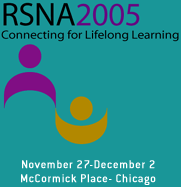
Abstract Archives of the RSNA, 2005
Athanasios Petrou, Presenter: Nothing to Disclose
Nikolaos Ptohis, Abstract Co-Author: Nothing to Disclose
Evangelia Sotiropoulou, Abstract Co-Author: Nothing to Disclose
Ioannis Mazarakis, Abstract Co-Author: Nothing to Disclose
Aggeliki Karatasiou, Abstract Co-Author: Nothing to Disclose
Petros Porfiridis, Abstract Co-Author: Nothing to Disclose
Vassilios Peppes, Abstract Co-Author: Nothing to Disclose
Konstantinos Vemmos, Abstract Co-Author: Nothing to Disclose
et al, Abstract Co-Author: Nothing to Disclose
Aim of this study was to evaluate the prevalence, radiological features and clinical importance of hemorrhagic transformation (HTR) in brain infarcts.
From a consecutive series of 1837 patients with acute ischemic stroke we studied 900 patients who fulfilled the following criteria: CT or MRI proven territorial infarcts, time from stroke onset to brain imaging>48 hours. The presence and type of HTR was noted and classified based on previous studies. Radiological features were assessed on imaging studies with and without HTR. Factors that may correlate to HTR were evaluated using multivariate regression analysis and the influence of HTR on outcome was determined using Kaplan-Meier estimates.
HTR was present in 191 of 900 patients (20.2%). Hemorrhagic infarct was found in 87.9% of the cases and intra-infarct hematoma in 12.1%. Hemorrhagic infarcts were mainly petechial (39.8%). The prevalence of HTR between anterior and posterior circulation was similar 21.2% and 22.1 respectively. The commonest stroke mechanism was cardioembolism (67.5%). In the multivariate regression analysis alcohol consumption, atrial fibrillation, fever during hospitalization, brain edema and infarct volume were independent factors predisposing to HTR. Early (30 days) and late mortality (8 years) was similar in cases with and without HTR (log rank test p=0.31 and p=0.47 respectively).
HTR appears in one fifth of ischemic strokes, usually after cardioembolism, and its commonest type is petechial. Infarct volume, alcohol consumption and fever predispose to HTR. HTR is part of the natural history of embolic stroke and not a complication that affects outcome.
Petrou, A,
Ptohis, N,
Sotiropoulou, E,
Mazarakis, I,
Karatasiou, A,
Porfiridis, P,
Peppes, V,
Vemmos, K,
et al, ,
Hemorrhagic Transformation of Brain Infarcts: Radiological Features and Clinical Importance. Radiological Society of North America 2005 Scientific Assembly and Annual Meeting, November 27 - December 2, 2005 ,Chicago IL.
http://archive.rsna.org/2005/4415566.html

